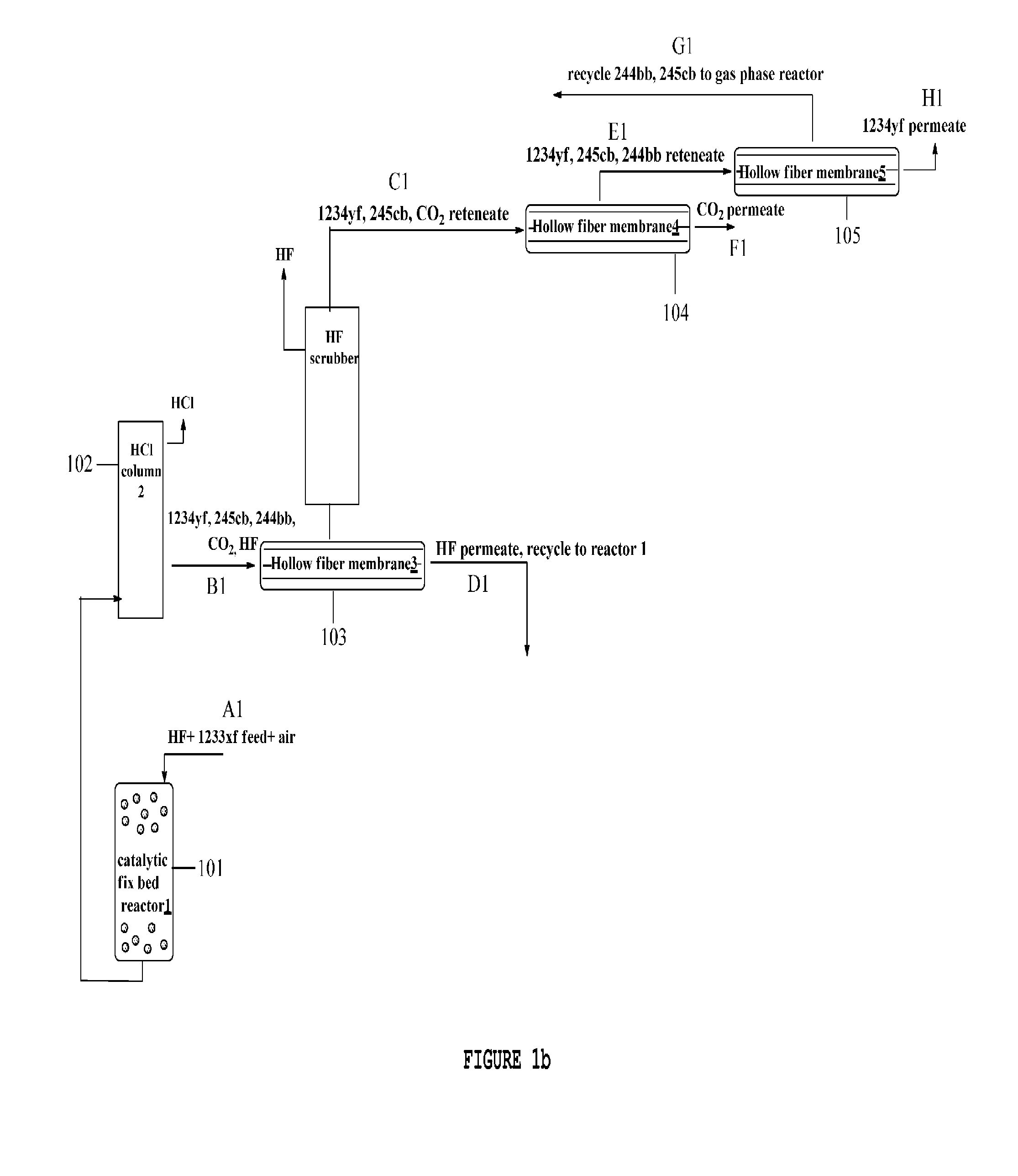Method for separating organofluorine compounds using membrane
a technology of organofluorine and membrane, which is applied in the separation/purification of halogenated hydrocarbons, separation processes, and products, etc., can solve the problems of limited use of sulfuric acid, further complicating the separation of organofluorine compounds, and substantial separation steps
- Summary
- Abstract
- Description
- Claims
- Application Information
AI Technical Summary
Benefits of technology
Problems solved by technology
Method used
Image
Examples
examples 1-6
Evaluation of Polymer Membrane for Chemical and Mechanical Stability
[0084]Experiments were carried out in triplicate as follow. Polymeric film approximately 1×1×¼ inch was placed in a 500 cc, stainless steel Parr reactor, which was leak tested with helium at 100 psig for approximately 30 minutes. Approximately 50 grams of anhydrous liquid HF was condensed into liquid nitrogen precooled Parr reactor, followed by another 50 grams of HFC-134a. Subsequently, the reactor was placed in a thermostated water bath, at 20° C. for two weeks. After venting the organofluorine compound and HF, the polymeric film was washed with plenty of water and was tested for any discoloration, weight loss or mechanical disintegration. An average of triplicate runs is reported in Table 1.
TABLE 1Chemical and mechanical stability of membrane material, in thepresenceof 50 / 50 weight % mixture of HF and HFC-134a (CF3CH2F),tested at 20° C. for two weeks.ExampleMembrane materialObservationRecommendation1CELGUARD ®Whi...
examples 7-15
Evaluation of Supported and Unsupported Polymeric Membrane for the Separation of 50 / 50 Weight % HF / HFC-134a Blend
[0085]A supported membrane such as KYNAR® 2801 PVDF on a Millipore 0.1 μm support was prepared as follows. 3 weight % solution of KYNAR® 2801 PVDF in acetone was sprayed onto a 142 mm diameter Millipore support. Several coats were applied to cover the entire support surface evenly. Typical membrane thicknesses of 0.8 to 5 μm were obtained. Leaks greater than one bubble every ten seconds were rejected for membrane testing.
[0086]The polymeric materials were cut into 47 mm discs (membrane) and placed in a modified Millipore SS filter holder (test cell) with stainless steel screens and TEFLON® O-rings. The test cells had Swagelok inlet and outlet ports on each side for the feed, rejectate and permeate flows. The test cell was placed in a constant temperature bath maintained at 20±1° C.
[0087]HF and 134a gases were fed from two separate stainless steel 316 lines. The flow rate ...
examples 16-27
Effect of Temperature on a Composite Membrane (KYNAR® 2801 PVDF Spray Coated on a Millipore Support)
[0089]The PVDF 2801-Millipore composite membrane was the most efficient membrane in separating HF from 134a mixture. In addition, it was stable in a HF environment for over 120 hours. Therefore, it can be used to recover HF and recycle it back to the gas phase reactor without additional purification. This membrane was further tested for the measurement of flux and durability of the membrane. The result obtained is shown in Table 3.
TABLE 3Separation performance of KYNAR ® 2801 PVDF supported on aMillipore support at 5 psiFluxPermeateg / m2 · hrAExampleHF / 134aFeed %HF / 134aHF / 134aT ° C.HF / 134a1610 / 1 91 / 1 94.4 / 5.6 14630 / 870301.661710 / 1 91 / 1 81.3 / 18.7 24380 / 559650.43183 / 175 / 2596.7 / 3.3 21381 / 723309.85193 / 175 / 2594.5 / 5.5 14711 / 860505.7201 / 150 / 5097.6 / 2.4 14629 / 3613040.55211 / 150 / 5097.8 / 2.2 17256 / 3785045.59221 / 420 / 8091.3 / 8.7 10209 / 9733041.98231 / 420 / 8091.1 / 8.9 6300 / 6165040.9224 1 / 16 5.88 / 94.1275.1...
PUM
| Property | Measurement | Unit |
|---|---|---|
| molecular weight | aaaaa | aaaaa |
| temperature | aaaaa | aaaaa |
| boiling points | aaaaa | aaaaa |
Abstract
Description
Claims
Application Information
 Login to View More
Login to View More - R&D
- Intellectual Property
- Life Sciences
- Materials
- Tech Scout
- Unparalleled Data Quality
- Higher Quality Content
- 60% Fewer Hallucinations
Browse by: Latest US Patents, China's latest patents, Technical Efficacy Thesaurus, Application Domain, Technology Topic, Popular Technical Reports.
© 2025 PatSnap. All rights reserved.Legal|Privacy policy|Modern Slavery Act Transparency Statement|Sitemap|About US| Contact US: help@patsnap.com



